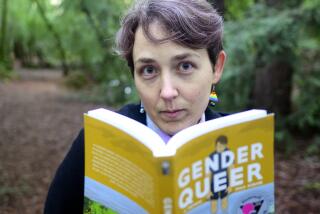Lessons in life from Goethe
JOHN ARMSTRONG knows he has an uphill battle in making a case for his subject, Johann Wolfgang von Goethe. The author even begins his book, “Love, Life, Goethe,” with the Dublin building-site joke he heard as a youth about how to say the German writer and philosopher’s name. “A new construction worker is a bit confused and asks: ‘Joist? Girder? What’s the difference?’ The foreman patiently explains: ‘Joist wrote “Ulysses,” Girder wrote “Faust.” ’ “
That brings us no closer to the correct pronunciation, but no matter. You know the name; you probably know that he wrote “Faust” and you might even know that he wrote “The Sorrows of Young Werther” and “Italian Journey.” More likely, though, Goethe -- whom James Joyce regarded as being in the great writers’ “Holy Trinity” along with Dante and Shakespeare -- is one of those classic writers you didn’t get around to in college, let alone high school.
Armstrong argues in this fine and useful book that Goethe was not only a literary genius but also someone who explored the human yearning for happiness in an imperfect world. Although it’s wise to heed Mississippi writer Walker Percy’s admonition that a self-help tract works only while one is reading it, Armstrong has written the perfect volume to read in early January as you break nearly every New Year’s resolution.
From his birth in 1749 in Frankfurt, it seems, Goethe was fortunate or just plain lucky. He had a happy childhood, loving parents and early literary success in Weimar, a vibrant European cultural capital. He was a lover of, and was loved by, many women, and he participated in many of the public events and debates of his day. He also was blessed by having a scrupulous record of his thoughts and beliefs kept by Johann Peter Eckermann and published as “Conversations With Eckermann, 1823 1832.” The moment when Goethe meets an admiring Napoleon, who had just sacked the author’s hometown, is delicious.
Armstrong divides his assessment of Goethe’s life into 10 parts: Luck, Love, Power, Art, War, Friendship, Nature, Peace, Happiness and Death. Instead of a dreary index, he provides a “thematic register,” allowing the reader to find intriguing quotes and topics that were of interest to his subject.
Armstrong’s intent is to examine aspects of Goethe’s life and literary works to show what we can learn from them. For example, he writes that as Goethe was preparing to leave his childhood home for Weimar, where he would spend the rest of his life, he wrote that his soul was “like a sock that is being turned inside out: the outer becoming the inner; the inner, outer.” At first glance, Armstrong writes, this seems to be “a disarmingly banal analogy.” On rereading, though, he notes that it is also “an avowal of a strikingly original ambition ... his thoughts and feelings seek external manifestations: the inner is to become outer. And through externalization his inner states will -- hopefully -- lose their fleeting, private and capricious character and be made precise, ordered and available to others.”
So, let’s not shy away from the big topic: What is the purpose of life? Goethe is famous for having written in his autobiography, “No one has ever understood another person; I never understood others and no one has ever understood me.” A common failure, you might say, but Armstrong argues that the purpose of life is not to become experts. “There will always be details of his life that we will not know unless we devote the whole of our existence to mastering the record of his. For the message Goethe is trying to send us isn’t a plea to understand him, or the impotent command that we become like him, but rather that like him we should take courage in an infinitely more worthwhile task -- that of becoming ourselves.”
All compelling biographical books require a good death scene. Armstrong and Goethe fulfill this demand: “He died at noon, in the armchair by his bed. Unable to speak, his fingers traced letters on the rug around his knees, still -- we are told careful in his punctuation.”
Thomas McGonigle is the author of “Going to Patchogue” and “The Corpse Dream of N. Petkov.”
More to Read
Sign up for our Book Club newsletter
Get the latest news, events and more from the Los Angeles Times Book Club, and help us get L.A. reading and talking.
You may occasionally receive promotional content from the Los Angeles Times.







